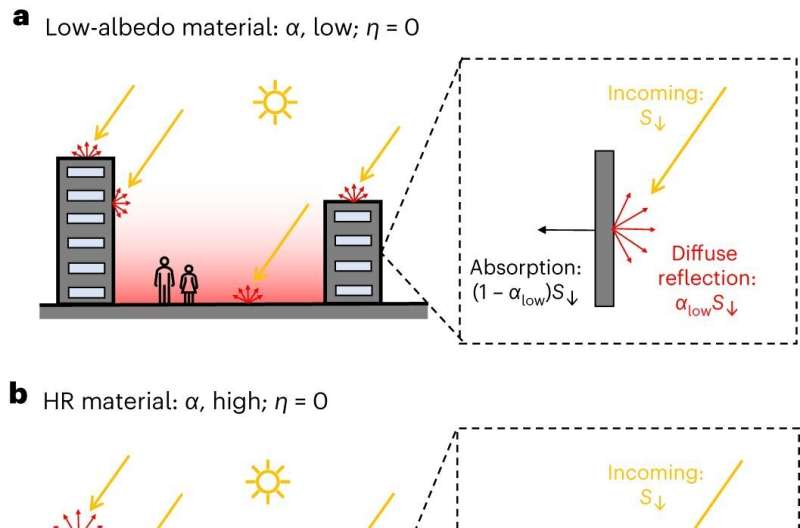
Engineers at Princeton University have quantified the cooling benefits of a simple solution for beating urban heat: reflecting solar radiation back from whence it came.
By outfitting building walls and roadways in dense urban centers with retro-reflective materials, which reflect most incoming light directly back to its source, the researchers found that it could be possible to reduce surface temperatures by up to 36°F, lower surrounding air temperatures by almost 5°F, and cool human skin temperatures by almost a degree Fahrenheit.
Such retro-reflective surfaces could be a key strategy for fending off urban heat in dense, high-rise cities like New York, Hong Kong, and Singapore. Working with collaborators from the University of Perugia in Italy, the team published their findings, including guidelines for installing retro-reflective surfaces in cities around the globe, on March 11 in Nature Cities. The paper it titled "Optimizing retro-reflective surfaces to untrap radiation and cool cities."
"More people die from extreme heat in the U.S. than from any other weather-related event—heat kills more than tornadoes, tsunamis, and hurricanes combined," said corresponding author Elie Bou-Zeid, professor of civil and environmental engineering. "And with climate change being linked to more frequent and long-lasting extreme heat events, there's an urgent need to develop and deploy technologies that can help people stay cool."
Owing to a lack of green spaces and an abundance of heat-trapping building materials, urban areas are often several degrees warmer than surrounding suburban and rural areas—a phenomenon known as the urban heat island effect. This makes people living in cities, including some of society's most vulnerable populations, particularly susceptible to the impacts of extreme heat.
Several technologies have been proposed to combat the issue of urban overheating, including cool pavements and roof coatings. These approaches can be as simple as painting the ground or rooftop in a shade of white to increase the amount of sunlight reflected from, rather than absorbed by, a city's built environment. In Phoenix, Arizona, for instance, cool pavement treatments have become a permanent part of the city's street maintenance program.
However, when sunlight hits these cooling technologies, it can bounce off in any number of angles instead of in one focused direction. This lack of control over the direction of the reflected light means that highly reflective materials could backfire if applied to the streets or walls of a dense urban area with tall buildings and comparatively narrow streets.
"Installing highly reflective technologies on building walls could be a serious problem, with respect to both the heat and general safety," said Bou-Zeid. "Those photons might be reflected out of the urban canyon, or they could be reflected onto the ground, onto other walls, and even onto the pedestrians themselves."
Unlike generic highly reflective materials, retro-reflectors can reflect incoming sunlight with limited scattering. Consequently, most sunlight hitting a retro-reflector on a building wall or city street would be directed back in the same direction it came from—and out of the urban canyon.
"In this way, the retro-reflectors can release the radiation that would otherwise be stuck in the urban canyon and exacerbate the urban overheating problem," said first author Xinjie Huang, a graduate student in civil and environmental engineering.
Retro-reflective materials are already used in the transportation sector, where they are commonly found in road signs and paint to enhance nighttime visibility. Other research groups at Princeton are even using retro-reflectors to help them pinpoint greenhouse gas leaks. But using retro-reflectors for cooling purposes in façade applications is still an evolving area of research.
"There are retro-reflectors on the market today, but an important question is how efficient we can make them and whether we can engineer them to have the properties we want," said co-author Jyotirmoy Mandal, assistant professor of civil and environmental engineering.
"Insights from optics and materials science allow us to choose the right materials and make the right design tweaks to push the performance of these technologies to their limit."
The present work did not focus on the materials science question of how to engineer the best retro-reflector for urban cooling. However, the researchers said their work is among the first to evaluate the potential cooling benefits of the technology at a global scale, moving beyond individual case studies to offer practical insights into how best to implement retro-reflective surfaces in cities around the world.
"Ultimately, we wanted to create a set of guidelines for policymakers, planners, and materials engineers," Huang said. "If you're an urban planner, for example, and you know the latitude of your city, the aspect ratio and the orientation of your streets, you can easily use our results to pick the optimal surfaces for implementing these retro-reflective materials and estimate the cooling benefits you might receive in doing so."
More information: Xinjie Huang et al, Optimizing retro-reflective surfaces to untrap radiation and cool cities, Nature Cities (2024). DOI: 10.1038/s44284-024-00047-3
Citation: Retro-reflectors could help future cities keep their cool (2024, April 17) retrieved 17 April 2024 from https://techxplore.com/news/2024-04-retro-reflectors-future-cities-cool.html
This document is subject to copyright. Apart from any fair dealing for the purpose of private study or research, no part may be reproduced without the written permission. The content is provided for information purposes only.
